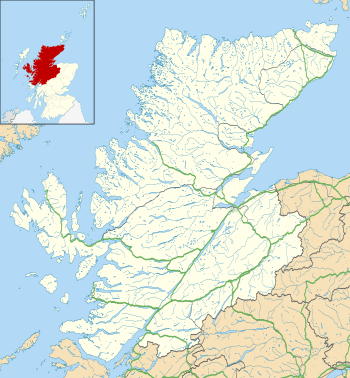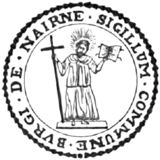Nairn
Nairn (/ˈnɛərn/ NAIRN; Scottish Gaelic: Inbhir Narann) is a town and former burgh in the Highland council area of Scotland. It is an ancient fishing port and market town around 17 miles (27 km) east of Inverness. It is the traditional county town of the Nairnshire.
Nairn
| |
|---|---|
 St Ninian's Church in Nairn | |
 Nairn Location within the Highland council area | |
| Population | 9,773 [1] |
| OS grid reference | NH887563 |
| • Edinburgh | 116 mi (187 km) |
| • London | 446 mi (718 km) |
| Council area | |
| Lieutenancy area |
|
| Country | Scotland |
| Sovereign state | United Kingdom |
| Post town | NAIRN |
| Postcode district | IV12 |
| Dialling code | 01667 |
| Police | Scotland |
| Fire | Scottish |
| Ambulance | Scottish |
| UK Parliament | |
| Scottish Parliament | |
As of the 2011 Census, Nairn had a population of 9,773, making it the third-largest settlement in the Highland council area, behind Inverness and Fort William.[1] Nairn is best known as a seaside resort, with two golf courses, award-winning beaches, a community centre/mid-scale arts venue (Nairn Community & Arts Centre),[2] a small theatre (called The Little Theatre[3]) and one small museum, providing information on the local area and incorporating the collection of the former Fishertown museum.
History

King James VI of Scotland visited the town in 1589 and is said to have later remarked that the High Street was so long that the people at either end spoke different languages, Scots and Gaelic. The landward farmers and the fishing families at the harbour end spoke Doric, and the highlanders spoke Gaelic.[4] Nairn, formerly split into Scottish Gaelic- and Scots-speaking communities, was a town of two halves in other ways. The narrow-streeted fishertown surrounds a harbour built by Thomas Telford while Victorian villas stand in the 'West End'. It is believed that the Duke of Cumberland stayed in Nairn the night before the battle of Culloden.
In 1645, during the Wars of the Three Kingdoms, the battle of Auldearn was fought near the town, between Royalists and Covenanters.
It was not until the 1860s that Nairn became a respectable and popular holiday town. Dr John Grigor (a statue of whom is located at Viewfield) was gifted a house in this coastal town and spent his retirement there. He valued its warm climate and advised his wealthy clients to holiday there. Following the opening of the Nairn railway station in 1855, new houses and hotels were built in the elegant West End. The station is on the Aberdeen to Inverness Line. Originally this was the last stop on the line from London due to the inhospitable terrain on what is now the main Dava branch line to Inverness.
Nairn has an expanse of sand beaches that were used extensively in training exercises for the Normandy landings during World War 2. The beaches around Nairn had landmines planted, during clearance operations in 1945 by 11th Company, Bomb Disposal, Royal Engineers. High pressure water jetting was used to displace shingle on top of mines to make clearance easier. Notably during this period two German spies who had been dropped by U-boat in the Moray Firth were arrested at Nairn railway station attempting to board a train to Inverness.
Parliamentary burgh
The burgh of Nairn was a parliamentary burgh, combined with the burghs of Inverness, Fortrose and Forres, in the Inverness Burghs constituency of the House of Commons of the Parliament of the United Kingdom from 1708 to 1918. The constituency was abolished in 1918 and the Forres and Nairn components were merged into the then new constituency of Moray and Nairn.
Nairn is currently represented by Scottish National Party MP Drew Hendry in the House of Commons of the United Kingdom.
Current developments
The A96 from Inverness to Aberdeen currently passes through Nairn town itself. Fergus Ewing, Scottish National Party MSP for Inverness and Nairn (and before 2011 Inverness East, Nairn and Lochaber), has been canvassing for a Nairn by-pass to be developed.[5]
At present Scottish Government investment in the transport infrastructure has focused on the Inverness to Nairn stretch of road, especially to improve links to Inverness Airport.[6] However, there are no current plans to build a Nairn by-pass. Land to the east and south of the town is being considered for the further development of 1400 houses, with additional plans submitted by Lord Cawdor to double the size of the town over the next 10–15 years through private investment.[7]
Nairn Improvement Community Enterprise was formed in 2010 as a company limited by guarantee to facilitate the regeneration of Nairn Town Centre and its surrounding areas and membership is open to all residents.[8]
Religion
The Old Parish Church, commonly known as Nairn Old Parish Church is on Academy Street in Nairn. It is still in use as a Church of Scotland church. St Columba's Episcopal Church is on Queen Street; the church was built of sandstone with a slate roof in 1857 and is still in use. There is also St. Mary's Roman Catholic Church in Academy Street, founded as a result of Gaelic-speaking Roman Catholics who moved from the island of Barra to Nairn in the second half of the 19th. century.[9]
Sport
Nairn is known as a golfing destination, with two 18 hole Championship golf courses. One of these, The Nairn Golf Club was established in 1887. Its designers include Archie Simpson, Old Tom Morris and James Braid. It has hosted many tournaments culminating in the 1999 Walker Cup and was the venue for the 2012 Curtis Cup. The second is Nairn Dunbar Golf Club.
The local football team is Nairn County F.C., who play in the Highland Football League who won the Highland League Championship in Season 1975/76. After a long lean spell of 31 years in 2006 they won the North of Scotland Cup 3-1 against local rivals Forres Mechanics F.C. at Grant Street Park, Inverness and they won again against Wick Academy F.C. in 2012. The town has another football team, Nairn St. Ninian F.C., who are members of the Scottish Junior Football Association and are based at Showfield Park.
Culture
The town also hosts the Nairn International Jazz Festival[10] each August, usually attracting some well-known and world class musicians. In 2007 Oscar-winning actress Tilda Swinton, who lives in Nairn, created a film festival entitled "Ballerina Ballroom Cinema of Dreams", which was held in the Nairn Public Hall.[11] It generated worldwide press about the festival and Nairn.[12]
Nairn is also the host for the annual Nairn Book & Arts festival[13] which takes place every year in September at the Nairn Community & Arts Centre.
Nairn is home to the Little Theatre, run by the Nairn Drama Club, which was established in 1946. Each year the club produces a number of shows, of varying genres, with the annual Christmas panto being the largest production of all. The Theatre began in dilapidated premises but was rebuilt and reopened in 2004.
Nairn stages one of the biggest Highland games in the North. The first event was held in 1867, and it is now one of the few where entry remains free. The games are a major event in the local social calendar.
Notable people
- Charlie Chaplin, used to holiday every year in Nairn and stayed at the Newton Hotel.[14]
- Margaret Fulton, food and cookery author, writer, journalist, author, and commentator. She was the first of this genre of writers in Australia.
- James Augustus Grant, who was the first European to discover the outpouring of the White Nile from Lake Victoria, together with Speke was born at Househill, attended Nairn Academy and died at Nairn in 1892. There is a plaque to his memory in St Paul's Cathedral.
- Frances Mary Hendry, author of children's historical fiction, resides in Nairn, where many of her books are set.
- Grenville Johnston, Lord Lieutenant of Moray, born here.
- Fraser Nelson, editor of The Spectator since 2009, was raised in Nairn.
- Tilda Swinton, actress and her children have resided in Nairn since 2007.
- David St John Thomas, British author and publisher resided here prior to his death in 2014.
- William Whitelaw, the British deputy Prime Minister 1979–88, was born in Nairn and has a street named after his family.
- George McCall Smith, notable New Zealand doctor
Climate
Like the rest of the British Isles, Nairn experiences a maritime climate with cool summers and mild winters. It is one of the driest locations in Scotland due to the rain shadowing effect of the surrounding mountains.
| Climate data for Nairn, 23m asl, 1971-2000, Extremes 1951-1980 | |||||||||||||
|---|---|---|---|---|---|---|---|---|---|---|---|---|---|
| Month | Jan | Feb | Mar | Apr | May | Jun | Jul | Aug | Sep | Oct | Nov | Dec | Year |
| Record high °C (°F) | 15.0 (59.0) |
15.0 (59.0) |
17.8 (64.0) |
19.4 (66.9) |
25.9 (78.6) |
27.8 (82.0) |
29.0 (84.2) |
30.6 (87.1) |
25.0 (77.0) |
24.4 (75.9) |
17.9 (64.2) |
14.3 (57.7) |
30.6 (87.1) |
| Average high °C (°F) | 6.3 (43.3) |
6.9 (44.4) |
8.7 (47.7) |
10.7 (51.3) |
13.8 (56.8) |
16.0 (60.8) |
18.3 (64.9) |
18.0 (64.4) |
15.5 (59.9) |
12.4 (54.3) |
8.8 (47.8) |
6.9 (44.4) |
11.9 (53.3) |
| Average low °C (°F) | 0.5 (32.9) |
0.3 (32.5) |
1.9 (35.4) |
3.2 (37.8) |
5.7 (42.3) |
8.4 (47.1) |
10.5 (50.9) |
10.1 (50.2) |
8.1 (46.6) |
5.8 (42.4) |
2.7 (36.9) |
1.0 (33.8) |
4.9 (40.7) |
| Record low °C (°F) | −12.8 (9.0) |
−16.7 (1.9) |
−11.1 (12.0) |
−6.7 (19.9) |
−3.3 (26.1) |
−2.2 (28.0) |
2.0 (35.6) |
0.5 (32.9) |
−1.9 (28.6) |
−3.3 (26.1) |
−10.6 (12.9) |
−12.2 (10.0) |
−16.7 (1.9) |
| Average precipitation mm (inches) | 51.94 (2.04) |
36.79 (1.45) |
42.51 (1.67) |
38.01 (1.50) |
43.92 (1.73) |
50.56 (1.99) |
48.38 (1.90) |
55.33 (2.18) |
60.34 (2.38) |
55.59 (2.19) |
57.49 (2.26) |
50.32 (1.98) |
591.18 (23.27) |
| Mean monthly sunshine hours | 44.18 | 76.18 | 101.39 | 129.58 | 175.39 | 156.08 | 153.68 | 146.95 | 114.94 | 88.50 | 53.84 | 33.49 | 1,274.2 |
| Source 1: Met Office[15] | |||||||||||||
| Source 2: ScotClim[16] | |||||||||||||
See also
References
- "Highland profile — key facts and figures". The Highland Council. 2016.
- "Home". nairncc.co.uk.
- "Nairn Drama Club". nairndrama.org.uk.
- Thomson, David (1998). Nairn in Darkness and Light. Vintage. ISBN 978-0-09-959990-6.
- "Parliamentary Questions & Answers".
- "A96 Corridor Plan" (PDF). Archived from the original (PDF) on 23 October 2007. Retrieved 10 November 2006.
- Ross, Calum. – "A96 corridor may house extra 9000".- The Inverness Courier. – 8 August 2006
- NICE Nairn Retrieved 19 April 2014.
- "St Columba's Episcopal, Nairn - Nairn, Highland - Places of Worship in Scotland - SCHR". www.scottishchurches.org.uk.
- "Jazz Nairn". jazznairn.org.
- "Ballerina Ballroom - Ballroom History". spanglefish.com.
- "Ballerina Ballroom - Home". spanglefish.com.
- Nairn Book & Arts festival
- McKenzie, Steven (14 July 2008). "The chronicles of Nairn-ia". BBC News. Retrieved 14 July 2014.
- "Caldecott 1961-90 averages". Met Office. Retrieved 2 November 2011.
- "Nairn extremes 1951-1980". weather.org.uk. Retrieved 2 November 2011.
External links
| Wikimedia Commons has media related to Nairn. |
- . Encyclopædia Britannica. 19 (11th ed.). 1911.
- A Gurn from Nurn with views on politics, culture, upcoming events etc.
- Nairn Scotland Portal offering a guide to visiting and living in the area.
- Nairn River Community Council
- VisitNairn Tourism and visitor information